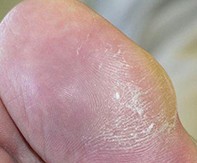Frank’s flat feet
The first article in this series addresses one of the basic foot structure types, the flat foot, and its associated pressure patterns and footwear needs. An appreciation of foot structure and the pressure areas in stance and gait is important. A simple check of foot structure and pressure areas can be included in the regular six-month foot check of your patients with diabetes (Table).
Case history
Frank is 23 years old with an eight-year history of type 1 diabetes that is well managed. His height is 1.84 m and weight 81 kg; thus his BMI is 23.92 kg/m2 (i.e. he is in the healthy weight range). His HbA1c is 6.5%, and he has had no hypoglycaemic episodes requiring external help.
Frank has normal foot pulses, healthy skin and no clinical evidence of peripheral neuropathy. He is a good footballer, plays tennis and likes to swim. His last football season was dogged by ‘shin splints’ (medial tibial stress syndrome), and he also had problems with callus build up (Figure 1) and sometimes blistering of the skin adjacent to the first metatarsophalangeal joint and the big toe. The weight-bearing areas of the feet show callus build up and his feet look quite flat when he stands and walks.

